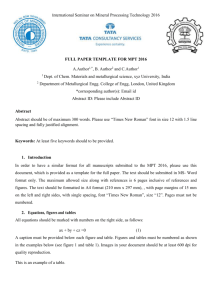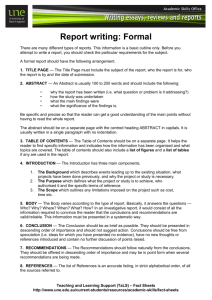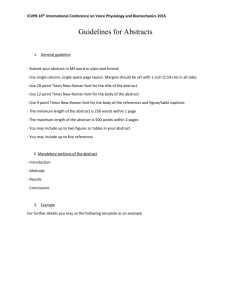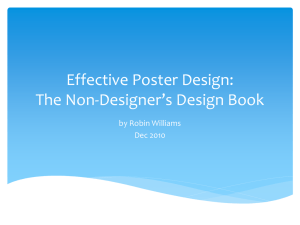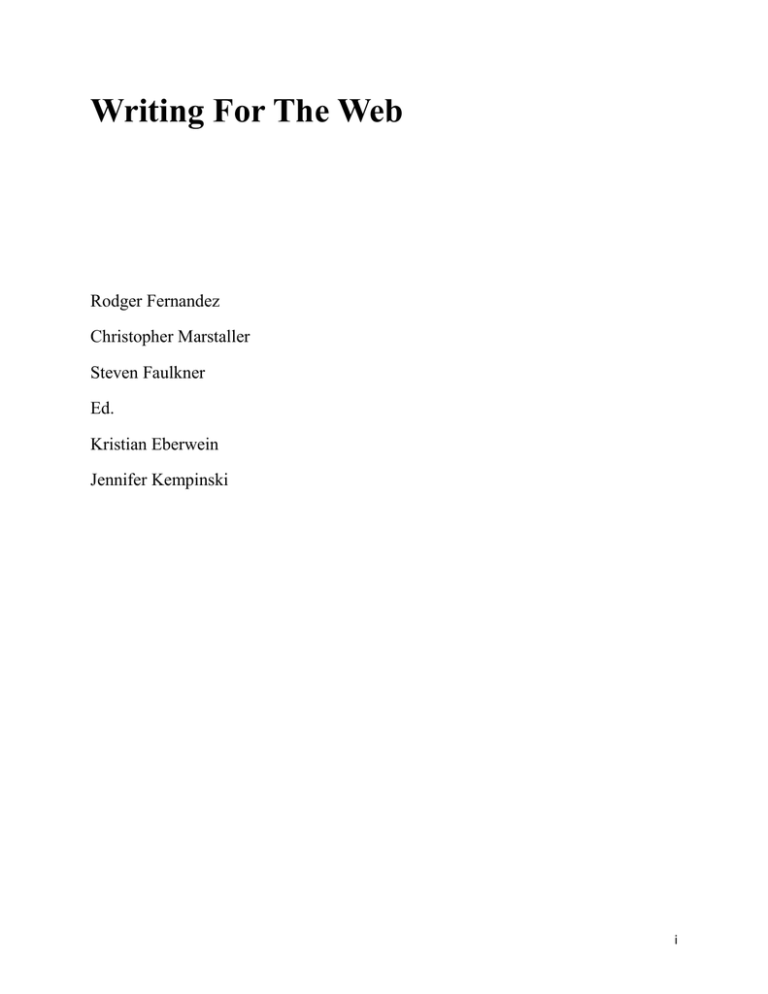
Writing For The Web
Rodger Fernandez
Christopher Marstaller
Steven Faulkner
Ed.
Kristian Eberwein
Jennifer Kempinski
i
Table of Contents
Background
History of Writing for the Internet
1
The Audience of the Internet
2
Internet Writing Styles
Style Length / Directness
3
Shorter Is Better
4
K.I.S.S.
4
If You Can Cut A Word, Cut It
5
Be Direct
5
Inverted Pyramid Style
6
Text and Background Color
6
Font Size
7
Technical Matter
Presentation of Documents on the Internet
Hypertext Markup Language (HTML)
13
Extensible Markup Language (XML)
14
Portable Document Files (PDFs)
15
ii
Background of Writing for the Internet
Writing for the Internet is a work in progress. The Internet is a world where rules can be
remade, bent, or outright broken. Despite the freedom of speech the Internet offers, fundamental
rules of grammar, style, and rhetoric still apply. There have been very few style guides that deal
entirely with writing for the internet. Writing style on the web, like the technology of the
Internet, are in a constant state of progression. This allows for an existing platform of textual
rhetoric to be combined with visual and audible rhetoric as well.
History of Writing for the Internet
During the infancy of the Internet, the writing styles mostly mimicked what readers and
writers had become accustomed to in the “brick and mortar” world. Most web pages were written
in either AP or MLA style with light use of graphics, fonts, and backgrounds. As the needs of
web users have changed, writers have altered their style to meet these needs. For example, a web
user in the late 1980’s was most likely resorting to the Internet for information that had been
directly transposed from a hard copy book or magazine. Books and microfilm were primary
sources for information so web pages needed to do very little in order to match the quality
offered by other sources. As technology progressed, so did the needs and expectations of web
users. Today, most users will not read a page, they will scan it for several seconds and decide if
that page will meet their needs or not. The need of web users to be supplied with information
quickly, clearly, and attractively has changed the way we write for the web.
1
The challenge writing for the web is to keep pages professional while maintaining the
interest of the audience. Because most pages are written informally, using slang terms and
abbreviations, it is often hard to keep up with information. Additionally, some pages can
bombard the user with ads and bright colors that seem out of place. Clever use of document
design is the key to keep web pages looking modern and fresh while still useable. Technology
has developed over time, we can now enhance the writing on our web pages with graphics and
the principles of design to emphasize the text we want to stand out and minimize the effect other
text might have. The high cost of paper and ink are not factors when writing for the web, this
allows authors much more freedom than with printed text. Freedom does come with a price.
There are specific rules that apply when writing for the Internet that may not make a difference
to printed documents.
The Audience of the Internet
Your audience is the first thing you should consider. As a writer it is your first and
foremost priority to be an advocate for your audience. Before your first word is written, it is
paramount to have a good understanding of whom you are writing to and what they expect from
you. It is important to choose a writing style that will have the most positive effect on your
reader. For example, you would not use the same writing style for a website designed to sell
skateboards as you would a website dedicated to academic research. Both audiences have
different needs and expectations. In Guide to Style and Grammar, Jack Lynch uses the analogy
that writing style is like clothing style. As outdated as many clothing styles may be (a jacket and
tie for example), those styles are expected in certain situations. You would not wear your
pajamas to a job interview, nor should you use slang terms on a website targeted at an academic
2
audience. The Internet is a completely open forum, so you may find blogs or forums where slang
and profanity are accepted and encouraged. If this is the case, think of yourself as hanging out in
a nightclub with your friends. The trick is to know how to “dress” your writing for each
occasion. When thinking of your audience, it is important to remember that the Internet is a
highly mobile entity where anything you type can be seen or shared by others.
When writing for a hard-copy publication, you already know what format your text will
be displayed on. When writing for the web, your text may be displayed on a 40 inch monitor or a
4 inch cell phone. It is important to consider how and where your audience will use your
information. For example, if you are writing a manual about IRS tax code, there is a strong
chance that your audience will be viewing your document on a full size monitor in an office, but
if you are writing an instruction manual about how to assemble a camping tent, you must
understand that your text may be viewed on a cell phone or portable reader. In this case, it is
necessary to make each sentence as clear and concise as possible to allow your reader to easily
use your document. Good writing doesn’t have to be grammatically perfect, but it does have to
be perfectly clear. The only way to be perfectly clear is to know what your audience expects of
you.
Internet Writing Styles
Sentence Length / Directness
People tend to read differently on the web than they do on hard copy. Many times a fuzzy
computer monitor is not as clear and crisp as hard copy print. People tend to scan the web to find
3
the information that they are looking for. If they cannot find any relevant information in the first
few seconds, they are likely to navigate to another page. Unlike a chapter in a book, a web reader
is likely to only scan headings, subheadings, and hyperlinks in order to decide if the web page
will meet their needs. There is more of a tendency for someone on the web to quickly scroll
through and jump around to different pages.
The best thing to remember about writing for the web is “shorter is better.” Many
experienced writers will tell you, it is more difficult to write what you want to say in 300 words
than it is to write the same thing in 1,000 words. There are many strategies that will help you
make your writing more concise and make your web document more successful.
Shorter is Better
Writers often have the tendency to begin a document with an introductory paragraph. As
writers, we are taught to do this from the time we learn how to write. When we first learn the
form of the “five paragraph essay,” we are taught to write an introduction and/or a thesis.
Internet readers are primarily concerned in the information that they are seeking. They are
usually not interested in the author’s impressions or theories about the subject. A good idea is to
cut out the introductory paragraph and replace that with an entertaining introduction sentence.
Don’t be afraid to insert some personality and flair into the introduction sentence. This is a
technique that newspaper journalists have been using for years. The more attention your first
sentence attracts, the more likely the reader is to keep reading the document.
K.I.S.S. (Keep it Simple Stupid)
4
If you are authoring a document on any subject, it is assumed by the reader that you know
something they don’t. The point is, they know you’re smart, so there’s no need to keep proving
it. Avoid overly complex words, metaphors, and concepts. There is no need to use four syllable
words that have one-syllable synonyms. The more often the reader has to stop, the more often
you give the reader a chance to navigate away from your page.
If You Can Cut a Word, Cut it
If you can take a word (or a sentence) out of the document, don’t be afraid to do it. In
first drafts, it is common for writers to use unnecessary modifiers or descriptive verbs. For
example, words like “very,” “more,” and “really,” can almost always be deleted. This practice
may seem like something small, but if you can delete all the unnecessary adjectives and adverbs
from a document, the length will be dramatically reduced. A nice trick is to go through the
document and delete all the modifiers. If the sentence still makes sense, go with it.
Be Direct
Readers on the web are usually hunting for specific information. They do not want to
have to wade through pages of text in order to find what they need. For example, if you are
writing an article on building an engine, start the article with “The best way to build an engine
is…” You may find that it would be helpful for the reader to know the history of the internal
combustion engine with a short biography of Henry Ford. This may very well be the case, but
you have to remember that what you want the reader to know and what the reader actually wants
to know may be different things. There are numerous documents and videos on the Internet that
will give your reader the information they are looking for in a quick and concise manner if you
5
cannot provide the information they require. The best strategy to prevent this is to pretend that
your article is a bulleted list. Follow the bullets of your article without putting superfluous
information or “padding” in the document.
Inverted Pyramid Style
Image your story is an upside down pyramid. Put the most important information first,
then go down the layers of the pyramid by putting the less important information towards the
bottom of the document. Journalists have been using this technique for decades. An advantage
this writing style gives the writer is the reader can stop reading the document at any time and
come away with an understanding of what it’s about.
Fig. 1 Illustrates the pyramid technique
By using this style, you can include information you think is valuable at the end, and
front-load the document with the most valuable information. For example, if you are writing an
article on a baseball game, start with the “who, what, when, where, why, and how,” and if you
feel it is worth noting that it was raining and the visiting team has never played on artificial turf,
you can include that information at the end without alienating the readers who may simply be
looking for the score of the game.
6
Text and Background Color
The readability of your writing is as important of the content of the writing itself. Your
goal as a writer should be to clearly communicate your thoughts or ideas to the reader. If the
content is visually irritating, the reader will often stop reading. If this case, you fail as a writer
not by your text, but by its readability.
The contrasting relationship between text and background is an area particularly
important to the Internet because there are far more options for production. When dealing with
hard copy print, it would be entirely too expensive to produce white text on a black field. The ink
cost of the black field would make the document impractical. However, because of the numerous
options of fonts and colors that the Internet provides, many authors have chosen to get creative
and use contrasts that make their text difficult to read.
There will be times you will make exceptions to these rules. For example, it may be
suitable to put red text on a black background if you are only using it for superfluous
information. If you are dealing with “body” text or text that should stand out, it is important to
follow a few standard conventions:
Dark text on a dark background. Think of black text on a white background of being your
standard. Any color modifications that you make should mimic this contrast scheme.
Avoid light, thin lettering on a dark background.
Avoid same-color contrasts. Dark green lettering on a light green text may fit into the
visual concept of your website, it will make the text seem invisible on the page.
The contrast scheme most fitting for the human eye is black print on a white background.
By using this contrast scheme you are able to fully showcase your typeface and make letter
7
recognition very easy for the reader. The opposite of this color scheme is white letters on a black
background. This scheme is also easy to read because of the extreme contrast, but the typeface of
white letters tend to slightly blur into the grey areas of the background. Many typefaces are
extremely intricate. For example, if you use a serif text on a black background, some of the
subtle “flags” or serifs of the individual letter may be blurred out.
Font and Size
Much like problems with color and contrast, problems with font and size are encountered
largely because of the thousands of options that an author has in the online universe. Just because
you have a font on your word processing program does not mean it will show up that way on
someone else’s web-browser. Microsoft, Macintosh, and Unix browsers all have font lists that
they support. Commonly recognized fonts for Microsoft and Macintosh browsers include:
Arial
Comic Sans
Georgia
Impact
Lucida Console
8
New Times Roman
Tahoma
Trebuchet
Verdana
Different fonts serve a wide variety of usages. Of the standard Microsoft and Macintosh
browser fonts, none are particularly unreadable by themselves, but in context some are difficult
to read.
For example, a large block of text written in “Impact” font is very dark and pushed
together. This is not advisable for longer blocks of text.
Fonts like Impact can be useful for headings, but for body text fonts like New Times
Roman or Georgia are more similar to what most of us are used to reading in books and
newspapers. This allows your readers eyes to effortlessly scan the text without having to stop.
The goal is to make reading the text as easy as possible for the reader. For this reason it is also
considered poor style to make your characters in all bold, italics, or caps.
An aspect of font that often goes overlooked is serif. There are two types of fonts,
serif and sans serif. A serif, or a “flag” is simply a small, stylized stroke that appears of the tops
and bottoms of the letters. Serif typeface is so popular that most readers don’t even notice it.
9
Serif
San Serif
The million-dollar question becomes, if it’s almost too small to notice, why should we
care? Even though readers may not consciously notice serifs on your typeface, there are
subconscious tendencies and associations to both kinds of typeface. Serif fonts are popular in
“body” text. Readers associate serif fonts with organized text such as newspaper articles. Sans
serif fonts have been found to draw the reader’s eyes downward, making them useful for use in
tables and lists.
Changing up the fonts on a web page will greatly improve the usability. Varying font
size, density, color, and even type of font will make a huge difference. To make text stand out,
the first thing that comes to mind is changing the size, then making it bold, then perhaps making
it all capitals or some other way of distinguishing its importance. A webpage can still look
professional and convey valuable information while maintaining creativity, which is something
to keep in mind when writing for the web. But be careful, because there are lots of fun elements
of text that should not be utilized. For instance, the “shadow” features on Microsoft Word and
outline, designs that could be found in WordArt, are too distracting and detract from readability.
Graphics are a great tool that can greatly enhance web pages and technical documents, but
should not be overused or used in a way that could be considered tacky.
Alignment within text is important as well. On web pages, you can align text to wrap
around an image or exclusively border the left or right hand side of the page. Depending on the
look you are going for, alignment can be very crucial to the success of your document’s success.
The most important considerations for text on the web are legibility, readability, and
usability. Legibility refers not only to the structure of the text itself, but the spacing, sentence
10
length, and paragraph length. Legibility affects readability more than the actual font itself. The
space between letters and how far apart they are from each other can be a factor of font choice,
but in general, readability will come from good formatting. Usability refers to the final results a
user gets out of a document. Were they able to find what they needed? Were they able to use
what they found to help them accomplish their task?
Finally, consider the following elements of a website: Site title, page title, headings,
individual paragraphs or content, and hyperlinks. Some documents may even have tables, lists,
or captions like the ones found within this document bordering the images. Websites and
technical documents are different, but a technical document may be posted on the web so these
considerations are important to remember.
Technical Matter
Presentation of Documents on the Internet
Some may find it difficult to believe that in the past slide projectors and cardboard
graphics were the main tool available for presentations. Today, giving an effective online
presentation has never been easier. First, we have a lot of software such as Microsoft PowerPoint
that has made easier give presentations online. Also tools like Google Docs, Dim Dim, and
WebEx Meeting from Cisco make technology easy to use so that writers can focus on content
rather than technology.
Tables are a good way to organize information on the Internet. The familiar look of tables
make them appealing to many readers. Tables come in different sizes and have different colors to
11
make the information in them stand out. The difference in using tables on the internet versus in
printed text is navigation. The ability to “scroll” through a page is something printed books do
not offer. In hard copy print, a table must fit the size of the page, or otherwise run onto the next
page. This can cut out information, and be confusing to use for the reader. Internet tables are not
confined to the special restrictions that exist in hard copy print, therefore they are able to present
an enormous amount of information in a relatively small space. Tables can provide a plethora of
information, and their uses can virtually span every topic.
12
Fig. 2: An example of a table that scrolls through what would be multiple pages of written text. This table has many
rows and columns
Figure 3: Continuation of the table from above and another, two row table
HyperText Markup Language (HTML)
The most predominate document type used on the Internet is HyperText Markup
Language (HTML). This markup language uses elements to build the layout and design of the
web document. Each element is written in the form of a tag which is enclosed in angle brackets
(like <html>). These tags are used by the Internet Browser the reader is using to view the
documents.
It is important that a member of your writing team understands the technical requirements
of creating an HTML document and styling that document. HTML alone started without any
text-formatting features. Over the years, Cascading Style Sheets (CSS) evolved to address this
issue. Like style sheets used in traditional book production, CSS allow definition of the
13
appearance and layout of text and other material display on an HTML document. CSS can be
internal (contained within an HTML document) or external (linked to from an HTML
document). The benefit of having site-wide CSS in an external file, is that changes can be made
to the style of the document in one change, instead of on each document, which can be both time
consuming and inaccurate.
HTML allows images and objects to be embedded and can be used to create interactive
documents, which contain objects such as forms. It also allows for structured documents
containing text formatting like headings, paragraphs, quotes, links, lists, and many other items.
Extensible Markup Language (XML)
Extensible Markup Language (XML) is a set of rules for encoding a document so that an
Internet Browser can display data to a user. XML is common for the exchange of data over the
Internet. The files include tags that describe a title, author, date, or headings. The most important
aspect of XML is style sheets, which are digital projections that tell the computer who to display
different types of metatags. The easiest way to think of a metatag is to think of text appearing
one way as one font on screen but in another font when actually printed. The metatags tell the
computer to print as a different font. XML has different “languages,” one of which is RSS. An
example of an RSS feed would be the social networking site, Twitter. In order to produce XML,
one must be familiar with programming. But all can benefit from the uses of XML.
14
Fig 4: An example of simple XML coding
Portable Document Files (PDFs)
PDF stands for Portable Document File. PDFs were developed by Adobe, who created
Acrobat, a special suite just for PDF files. A PDF can be viewed either on screen through the
Adobe Acrobat Reader application or online if the Acrobat Reader plug-in is installed on the
user’s web browser. A PDF can contain text and images, as well as other interactive features
such as check boxes, fill in forms, and page numbering. From a PDF file a user can search, print,
15
and highlight and copy and paste text if it is a version of Acrobat that allows hyper-text.
Fig 5: An example of a PDF found on the UCF webpage. Note the key features: search, table of contents, print, and
zoom in and out keys
A user can save a Microsoft Word Document as a PDF file, then upload it to share with
team members or co-workers to share a more professional, finished looking product than just a
plain Word document. A PDF can’t be edited by anyone else once they download it and the
unsightly red lines for typos or under unusual last names, green lines for grammar mistakes, and
formatting symbols will disappear. Also, Adobe Photoshop documents can be saved as PDF
files, either as just an image or an image with text.
PDFs have proven to be one of the most usable ways to communicate documents over the
web. PDFs bridge the gap between the screen and print. The convenient thing about PDFs is that
they can be printed in almost exactly the way they appear online or on the screen, which
16
correlates to how they appear online in virtually the same manner as they do in Microsoft Word.
PDFs can also be beneficial to those who have trouble reading things on the screen as there is a
zoom in and out feature that can enlarge the text to a comfortable size.
Summary
Writing for the web can be very different from writing in other formats, but it still
incorporates many of the same concepts that are common in print documents. From the early
stages of the Internet were documents resembled their printed counterparts, the documents were
simple, but as the technological background of the Internet evolved and the systems used to
access these electronic documents became more widespread, the style of electronic documents
changed allowing for the existing platform of textual rhetoric to be combined with visual and
audible rhetoric. With technology always changing, there are common standards for digital
distribution of documents, such as PDF files, and the standards for website pages using HTML,
but the constant changing of devices, browsers, and screen sizes make writing for the web an ongoing project. In the end, this allows the writers to instantly make changes to the way your
audience views the information you are presenting, which can help keep your audience engaged
with the information you are presenting.
17
Works Cited:
Kimball, Miles A., and Ann R. Hawkins. Document Design: a Guide for Technical Communicators. Boston:
Bedford/St. Martin's, 2008. Print.
Kirszner, Laurie G., and Stephen R. Mandell. The Holt Handbook. New York: Holt, Rinehart and Winston,
1986. Print.
Sebesta, Robert W. Programming the World Wide Web. Boston: Pearson Addison Wesley, 2008. Print.
Williams, Joseph M. Style Lessons in Clarity and Grace. New York[u.a.: Pearson Longman, 2007. Print.
Wolfe, Joanna. Team Writing: a Guide to Working in Groups. Boston: Bedford/St. Martin's, 2010. Print.
Rude, Carolyn D., David Dayton, and Bruce Maylath. Technical Editing. New York: Longman, 2006. Print.
Purdue University Online Writing Lab (OWL). Web. 25 Nov. 2011. <http://owl.english.purdue.edu>.
18


